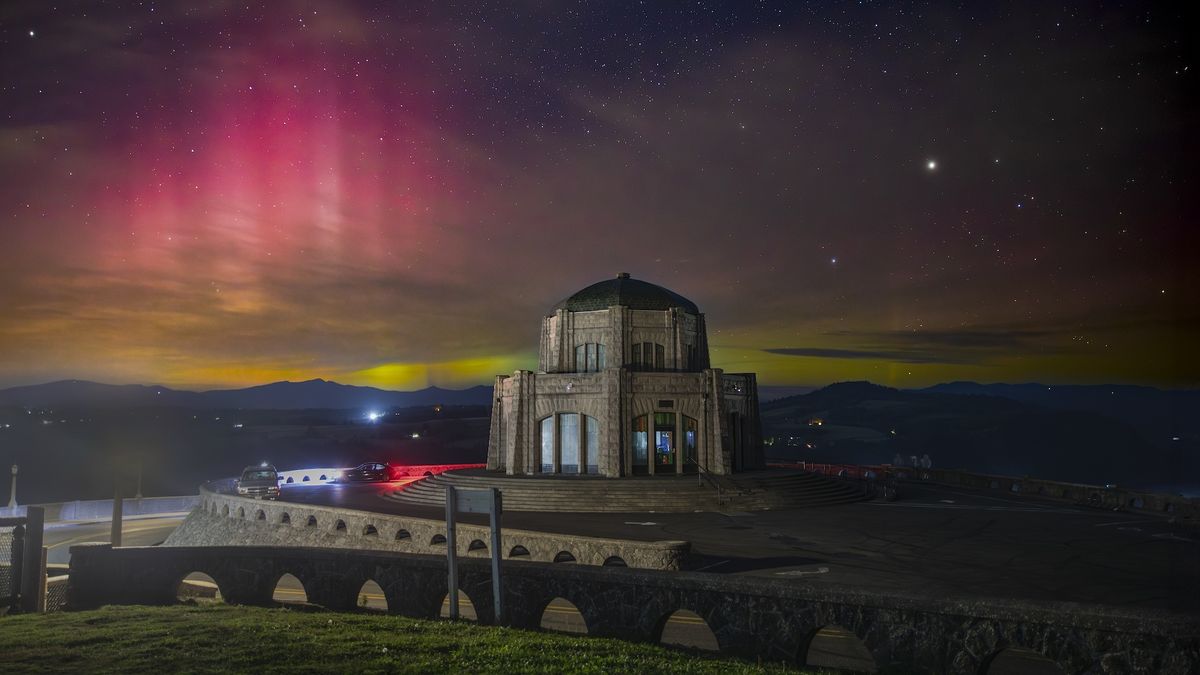Auroras could paint the skies Monday (Sept. 16) at much lower latitudes than usual as a “strong” G3-class geomagnetic storm crackles through Earth’s atmosphere, according to the latest report from the National Oceanic and Atmospheric Administration’s (NOAA) Space Weather Prediction Center.
The northern lights could be visible as far south as Oregon, Iowa and Pennsylvania tonight, with many states along the U.S.-Canada border likely to get a good view, according to NOAA. However, the presence of the nearly full Harvest Moon overhead may make it harder to spot vibrant auroras than it would be on a truly dark night.
Geomagnetic storms occur when massive blobs of charged solar material — called coronal mass ejections (CMEs) — pass over Earth at high speeds, colliding with our planet’s magnetic field. As charged solar particles skate along the planet’s magnetic-field lines toward the North and South poles, they bump into and excite atmospheric molecules such as oxygen and nitrogen, forcing those molecules to emit energy in the form of colorful auroral light.
Scientists detected a large CME blasting out of the sun on Saturday (Sept. 14), just after a powerful flash of electromagnetic energy known as a solar flare erupted from the sunspot AR3825. NOAA calculated the flare to be an X4.5-class explosion — the most powerful class of solar flare possible — and predicted Earth would likely sustain a glancing blow from the large CME that followed.
The “strong” G3-class storm due to hit Earth today ranks in the middle of NOAA’s five-level geomagnetic storm scale, with G1-class storms dubbed “minor” and G5-class storms seen as “extreme.” Along with the appearance of midlatitude auroras, G3 storms can disrupt GPS systems, low-frequency radio communications and certain satellite functions, according to NOAA.
Related: 32 stunning photos of auroras seen from space
To view auroras, head as far from artificial light sources as possible, using a dark sky map if needed. This will be particularly important given tonight’s bright moon. You can see auroras with the naked eye (no stargazing binoculars are necessary), but a smartphone camera should be able to capture the atmospheric light show with even greater sensitivity.
Solar flares, CMEs and powerful geomagnetic storms all become more common near solar maximum, the sun’s period of peak activity in its 11-year cycle. The current cycle’s maximum was initially predicted to begin in 2025, but some experts suspect it may already be upon us.
Besides the influence of solar maximum, auroral activity tends to increase in September near the autumnal equinox, thanks to a quirk of Earth’s tilt relative to the sun. When Earth faces the sun side-on during the equinox (which falls on Sunday, Sept. 22 this year) charged particles in the solar wind can reach the poles more easily, generating auroras along the way. If you can’t find suitably dark skies for tonight’s auroral display, expect another chance later in the month.

